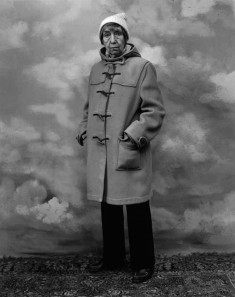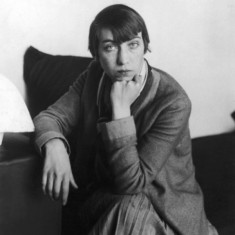| Berenice Abbott | |
|---|---|
 |
|
| Photographer | |
| Born | July 17, 1898 Springfield, Ohio |
| Died | Dec. 9, 1991 Monson, Maine |
| Nationality | American |
Born on July 17, 1898, in Springfield, Ohio, Berenice Abbott was a photographer who became famous for documenting the architectural landscape of New York City in the 1930s. An innovator of the straight or pure photography style, she was part of the West Coast Photographic Movement, a close-knit community of American photographers.
Early Years
The famous photographer was born Bernice Abbott and she was raised by her divorced mother in Springfield, Ohio. She briefly attended Ohio State University before moving to Greenwich Village. In 1921, she arrived in Paris to study sculpting with Emile Bourdelle.
Beginnings of a Career
Abbott was apprenticed to American expatriate Man Ray’s photography studio in Paris. Soon after, she opened a successful portrait studio where she took photos of various intellectuals and artists living in the late 1920s in Paris, including French photographer Eugene Atget, Irish writer James Joyce, and French novelist Jean Cocteau.
She was introduced to Eugene Atget’s works by Man Ray in 1925 and utterly impressed by his photographs, she decided to promote the late French photographer in her native country. In 1929, she returned to New York in order to find a publisher for Atget’s work and she was captivated by the technological and social progress experienced by the city.
She captured the city’s rapidly changing urban design using initially a hand-held Kurt-Bentzin camera. Later she acquired the large format Century Universal camera which she used for her famous “Changing New York” project, on which she worked independently for nearly six years. In 1933, she began teaching photography at the New School of Social Research, where she worked until 1958.
Abbott’s Major Works
Abbott’s critically-acclaimed and most recognizable documentary project, “Changing New York,” captured both realistically and objectively the newly-built skyscrapers and bridges replacing the older architectural structures and the animate street scene. This popular collection of photographs has come to define New York during the Great Depression.
 In 1939, she published her first book entitled Changing New York (reprinted in 1973 as New York in the Thirties), which gathers 200 of her 307 canonical photographs documenting the evolving architectural landscape of New York City, photos which were taken between 1935 and 1939 with the support of WPA.
In 1939, she published her first book entitled Changing New York (reprinted in 1973 as New York in the Thirties), which gathers 200 of her 307 canonical photographs documenting the evolving architectural landscape of New York City, photos which were taken between 1935 and 1939 with the support of WPA.
Greatly influenced by Eugene Atget’s approach to documenting Paris with sparsely populated streets, bridges and shop fronts, Berenice Abbott created memorable and realistic photos documenting the ”fantastic” contrast between the old and the new in New York architecture. She shot her photographs with an intense clarity of vision and exceptional attention to detail.
Later Life and Death
Abbott also contributed to the development of scientific photography; she argued that photography is a realistic medium that is appropriate for a realistic and scientific era. Abbott was also an inventor; the telescopic lighting pole (known as the autopole) and the distortion easel are two inventions credited to her in the field of photography.
Her scientific photographs taken, in 1958 for a physics textbook, were recently displayed at the MIT Museum. For nearly two decades, she continued to photograph the ever-changing American scene; in the 1950s she documented US Route 1 from Maine to Florida and in the 1960s, she documented Maine as a resident of the northeastern state.
Berenice Abbott passed away at the age of 93 on December 9, 1991, in Monson, Maine.